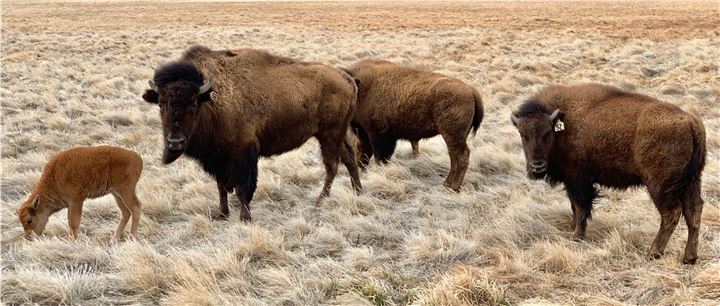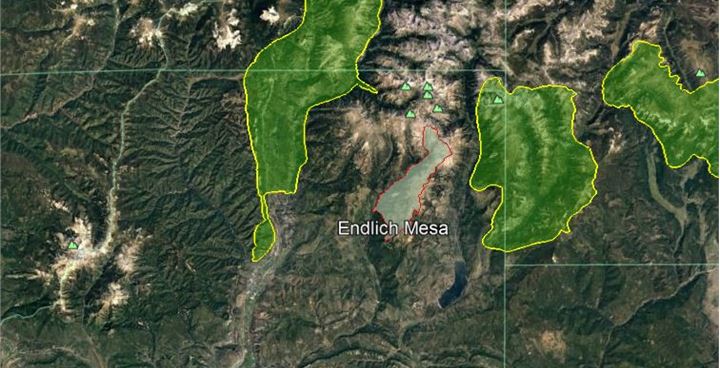Representatives of the National Wildlife Federation, and Walker Foundation, meet with a rancher grazing cattle on a leased allotment within Capitol Reef National Park. NWF is working to identify better quality grazing land outside the park and negotiate an end to grazing within the Park. The Foundation is supporting the purchase and retirement of grazing leases on federal land that benefits both private sellers and wildlife.
Purpose
- Investigates the causes of economic imbalances.
- Investigates causes tending to destroy or impair the free-market system.
- Explores and develops market-based solutions.
Summary
The National Wildlife Federation (NWF) resolves conflicts between wildlife and livestock through the market-based approach of compensating ranchers for retiring problematic grazing leases on federal land. Restoring wildlife populations has been linked to recovering healthy, functioning ecosystems.
Thanks to the Walker Foundation and other funders, NWF has been able to retire 70 grazing allotments, totaling approximately 1.3 million acres. This approach establishes an important national model for resolving chronic conflicts between wildlife and livestock. Following the success of the program in the Northern Rockies, in 2017 NWF decided to expand the scope of the project to the Southern Rockies, the Colorado Plateau and the Great Basin states of Colorado, New Mexico, Nevada and Utah.

Bison grazing on private land near Capitol Reef National Park. The National Wildlife Federation is negotiating to retire grazing on federal allotments to allow more space for the Henry Mountains Bison herd. The bison utilize lower elevation areas east of the Park that are currently leased for livestock grazing.
Description
The support from the Alex C. Walker Foundation has supported expansion of the WCR program to the Southern Rockies, the Colorado Plateau and the Great Basin. Thanks to this support, program staff have negotiated four allotment retirements in 2019 alone. When combined with a large retirement in the Northern Rockies, the WCR program has now eliminated livestock / wildlife conflicts on 200,000 acres in 2019 and over 1.5 million acres of public land since the inception of the program in 2002. All of these allotments will benefit Bighorn Sheep, but will also begin the restoration of the range condition of these allotments improving habitat for many additional species and well as significant increasing the carbon sequestered on all of these allotments.
Capitol Reef and the Sandy 3 Cattle Allotment
Following the site visit with members of the Foundation’s board to visit the recently completed Hartnet cattle allotment retirement, NWF has had ongoing discussions with the permittee of the Sandy 3 cattle allotment, the last active grazing allotment in Capitol Reef National Park. We have also been in discussions with the permit holders for several BLM cattle allotments just east of the park regarding their interest in retiring at least one of those that would then be traded to Boone in exchange for waiving his Sandy 3 permit. In addition, we have been in discussion with the Utah Division of Wildlife Resource regarding the retirement of some of these same allotments to allow more space for the Henry Mountains Bison herd that utilizes the lower elevation areas east of the Park. Although we do not have any immediate opportunities regarding the acquisition of an allotment for Boone nor for additional allotment retirements to benefit this free-ranging herd of Bison, the good news is that the various parties are looking to NWF as a partner that can help alleviate both of these conflicts. We are optimistic that we will resolve the Sandy 3 allotment conflict in the next 12 months.
Upper Crystal River Domestic Sheep Allotment
In the summer of this year, NWF finalized an agreement with the permittee for the 33,000 acre Upper Crystal River domestic sheep allotment high in the Elk Range of Colorado. Much of the allotment is in the Snowmass-Maroon Bells Wilderness Area just south of Aspen and in one of the most highly visited and iconic high elevation areas in the U.S. Given its location, this allotment has received a good bit of media attention with more coming in early 2020. We will send a fact sheet that provides further details on this deal, but the best news is that this was the only allotment in the Elk Range that threatened the Snowmass Bighorn Sheep herd and by permanently removing sheep, we have eliminated the risk of pathogen transmission between domestic and wild sheep. It is rare that we can protect an entire herd with the retirement of a single allotment.
Santos Domestic Sheep Allotment
In September, NWF negotiated the buy-out and signed agreement with the permittee of a very high priority domestic sheep allotment in Northern New Mexico, just to the west of Taos and the Rio Grande Gorge herd of Bighorn sheep. Although we are working with the US Forest Service on the final terms of the allotment’s closure, this is a very exciting development that will go a long way in protecting what is the largest herd of Bighorn Sheep in the U.S. We will provide an update on this allotment retirement in our next report, but we have been assured by the Forest Service that they support this effort so it is now just a matter or working through the federal agency’s process. We have attached a fact sheet for this retirement that provides additional details. This is one of only two remaining domestic sheep allotments in this part of Northern New Mexico and the good news is that we are currently negotiating the retirement of the Servilleta, the second allotment. We should note that this is the largest Bighorn Sheep herd in the U.S. and also happens to be disease free despite the significant risk of contact posed by the Santos and Servilleta allotments over the last 15 years. Although Bighorns were historically present in the Gorge as demonstrated by multiple petroglyphs, they were extirpated at least 250 years ago. In a joint effort between the Taos Pueblo and New Mexico Game and Fish, 24 Rocky Mountain Bighorns were transplanted in 2005 by the Pueblo and 25 the following year by the state agency. The conditions are ideal for wild sheep with the population having increased to well over 400 in the last 15 years. In addition to being of great cultural importance to the Pueblo, they have become a significant tourist attraction thanks to their visibility by visitors to the Gorge and in fact there are few places in North America where Bighorn sheep can be seen. Of all of the allotments retired this year, these two allotments have been the most degraded by overgrazing. The retirement of the Santos and ultimately the Servilleta will allow for the recovery of 20,000 acres and the concomitant carbon sequestered. As of April of 2020, we are happy to report that we have completed the retirement of the Santos Allotment, which will prevent stocking of domestic sheep or any other livestock on this allotment and will thereby, significantly reduce the risk of pathogen transmission between domestic and wild sheep.
Endlich Mesa Allotment
As of January of this year, we are pleased to announce that we finalized the retirement of a very high priority allotment just east of Durango, CO. I have uploaded a fact sheet for this deal, but it is 11,000 acres and permitted for 650 AUMs (1,000 ewes and their lambs) for a period of approximately three months. The Bighorn Sheep herd that is threatened by these domestic sheep is just to the east of this allotment in the Weminuche Wilderness Area which in the San Juan National Forest. Note that this permittee has three more domestic sheep allotments just to the west of the Endlich Mesa allotment, so despite significant mitigating the threat, we are looking forward to negotiating the retirement of his remaining three allotments over the next several years.

Endlich Mesa Allotment Map
Purpose
As a matter of law, wildlife conservation interests are not allowed to compete with livestock producers for grazing leases on public lands. As a result the market system is constrained from finding an appropriate balance between the need for livestock grazing and the need for wildlife. Our approach recognizes the economic value of grazing permits and compensates livestock producers fairly for giving them up. NWF's approach of paying ranchers to retire grazing leases where there is chronic conflict between livestock and wildlife provides a market- based solution for resolving these conflicts.
Scope
Conflicts between livestock and wildlife on public lands have been ongoing for several decades. The tactic favored by most environmental organizations has been to compel federal agencies through litigation and lobbying to administratively cancel troublesome leases. This approach has been only marginally successful and has generated a great deal of controversy, exacerbating the divisions between the livestock industry and the conservation community. Regarding geographic scope, the expansion of the program to Colorado, New Mexico, Nevada and Utah can be seen as a start-up. Whereas our nearly two decades of success in the Northern Rockies has generated a significant donor base and network of supporters, we are working hard to develop an equally solid platform that will support our work and hundreds of thousands of grazing allotment retirements for years to come.
Information Dissemination
In the past, the WCR program has preferred to operate somewhat quietly in an effort to avoid inflaming the livestock industry. However in the last year, we have been proactively communicating in the press and via NWF social media the benefits of our unique market-based approach. As noted above, the Upper Crystal River allotment retired garnered some good press in the local Aspen newspaper and will be featured in an in-depth story that will likely be picked up by outlets across Colorado and perhaps beyond.
Project Link http://nwf.org/wcr
Amount Approved$30,000.00
on 6/7/2019
(Check sent: 6/14/2019)